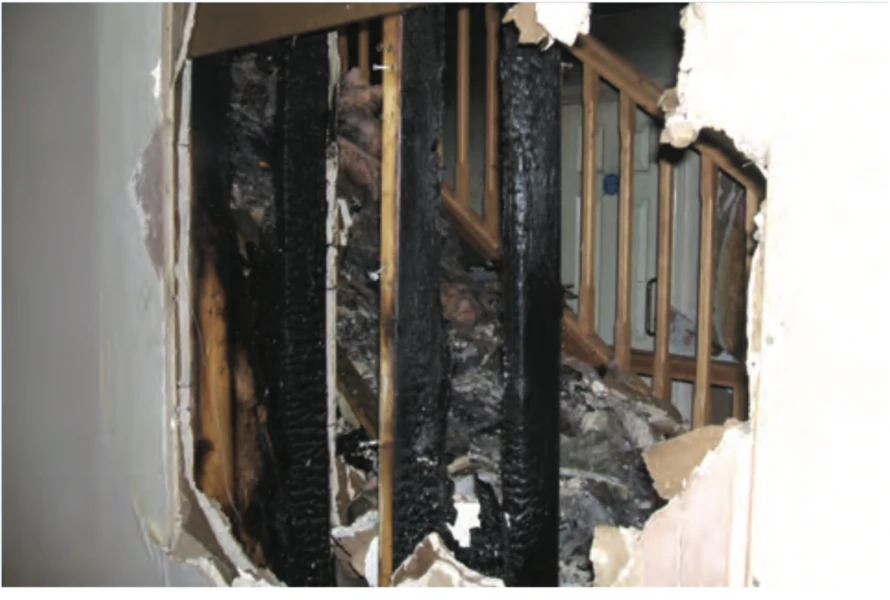Introduction- Passive Fire Products News would like to share a brief section from the guide electricalsafetyfirst.org.uk on the electrical sector.
The guide addresses the impact that electrical installations in domestic premises have on the fire performance of loadbearing and non-loadbearing walls and floors (and sometimes ceiling membranes) that have a fire containment function, or are required to carry a load for a prescribed period.
The advice given in Guide is aimed largely at preserving the structural stability of the premises as much as the fire separation between areas. For example, in most domestic premises, it is the loadbearing capacity of the floors that is threatened by early failure of ceiling linings, not the fire separating function.
Many modern forms of engineered construction have an inherently lower level of fire resistance when compared to more traditional forms of construction, and are heavily reliant on the plasterboard or similar linings for achieving the requisite level of fire separation.
Electrical equipment that has been identified as having a direct and significant influence on the fire performance of buildings includes:
Flush-mounted consumer units
Concealed and recessed luminaires, including downlighter
Flush-mounted electrical socket-outlets, flex outlet plates and data points
Flush-mounted switches, detection and control devices
Recessed wall luminaries
Concealed speakers
The above items all require the removal of a part of the ceiling or wall lining, and replacement with glass, thin metal or plastic that does not provide the same level of fire protection to the structural members, causing a reduction in the fire performance of the element. These are known as partial penetrations.
In addition to the influence that these partial penetrations have on the fire performance, some installations can penetrate both linings, such as:
Associated wiring and conduits
Ventilation fans and related ductwork
These installations have a potential to compromise the fire containment capability, and guidance is included for these situations. These are known as full penetrations.
The fire separating capability of an element of construction is generally measured by the duration for which the element will satisfy the criteria of a fire resistance test. Historically, these criteria have been determined by exposure to the BS 476: Part 20: 1987 heating and pressure conditions, but more recently by the new European testing regime as embodied in BS EN 1363-1. More information on the relevant test methods and criteria can be found in Annex B.
The Guide gives recommendations as to what is considered to be best practice, taking into account that electrical installers may not have adequate knowledge of the construction of the elements that are potentially being compromised by their work.
General electrical installation requirements
This Guide also takes into account the publication of BS 7671: 2008 (Requirements for Electrical Installations, IEE Wiring Regulations 17th Edition), which is the latest version of the national standard for the safety of electrical installations, first published in 1882.
BS 7671 requires, in Section 421 (Protection against fire caused by electrical equipment), that equipment must not present a fire hazard to adjacent materials, and that manufacturers’ instructions must be complied with. Section 421 also requires that fixed equipment causing a concentration and focusing of heat (such as spot lamps) shall be at a sufficient distance from any fixed object or building element so that the object or element is not subjected to a dangerous temperature in normal conditions.
Where a wiring system passes through elements of building construction such as floors, walls, roofs, ceilings, partitions or cavity barriers, the openings remaining after the passage of the wiring system must be sealed according to the degree of fire resistance (if any) prescribed for the respective element of building construction before penetration (Regulation 527.2.1).
For more regulations on installation and full report please visit please read full guide.
http://www.electricalsafetyfirst.org.uk/mediafile/100126681/Best-Practice-Guide-5.pdf
RECOMMENDATIONS
Passive Fire Products offer a full range of solution for the electrical sector please and have a full technical team to offering professional advice for your application. Always speak to a professional if unsure of the protection required for your application.
Explore Full Electrical Range. Click Here





